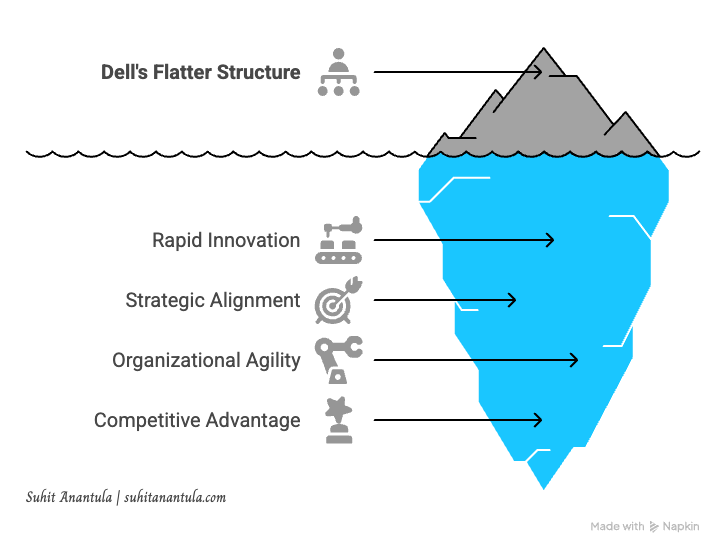Structure and Strategy in the AI Age : The Helix Blueprint Dispatch
Exploring Chandler’s timeless framework in the context of AI-driven transformation
In his groundbreaking 1962 book, Strategy and Structure, Alfred Chandler introduced a foundational concept in management theory: structure follows strategy.
Chandler argued that for a company to perform at its best, its organisational structure must be designed to support its strategic objectives. This idea, born in the mid-20th century, resonates powerfully today as we witness the rise of artificial intelligence (AI) reshaping the tech industry. As companies pivot their strategies to embrace AI, they are rethinking their structures to stay competitive. This article dives into how tech companies are evolving in the AI Age, using Chandler’s framework as a lens to understand these changes.
The Strategic Shift: AI as a Game-Changer
AI isn’t just another technological advancement—it’s a paradigm shift that’s redefining how tech companies operate and compete. Unlike traditional software, which relies on predefined rules, AI leverages machine learning, vast datasets, and predictive capabilities to create value in entirely new ways.
This shift is driving profound changes in corporate strategy:
Innovating Products and Services: AI enables companies to deliver smarter, more personalised offerings. For instance, Amazon and Netflix use AI-powered recommendation engines to boost customer engagement and revenue. Tesla’s pursuit of autonomous driving technology through AI positions it as a leader in the automotive sector’s transformation.
Enhancing Operations: AI streamlines processes by automating repetitive tasks, optimising supply chains, and improving decision-making. Google’s AI-enhanced search algorithms and Microsoft’s AI-infused cloud services are prime examples of operational excellence driven by AI.
Redefining Competition: In the AI Age, staying ahead means mastering AI. Companies that integrate AI into their core strategies can disrupt traditional business models, while those that lag risk losing market share to more agile, AI-savvy rivals.
This strategic pivot isn’t optional—it’s a necessity. As Chandler noted, when a company’s strategy evolves, its structure must adapt to support the new direction. In the AI Age, that adaptation is both urgent and complex.
Structural Changes: Building Organisations for AI
To execute their AI-driven strategies, tech companies are rethinking their organisational designs. As Chandler argued, structure must follow strategy—and in the AI Age, this alignment is more critical than ever. Here’s how companies are making it happen:
Dedicated AI Units: Companies like Google, with DeepMind, and Microsoft, with its AI Research division, have created specialised units to drive AI innovation and integration.
AI Across the Organisation: AI expertise is being embedded into existing teams, ensuring products are built with AI at their core from the start.
Talent Transformation: Firms are upskilling employees and hiring specialists—think data scientists and AI ethicists—often reshaping teams to accommodate these new roles.
Flatter Structures for Agility: Some companies are flattening their hierarchies to stay nimble. Take Dell, for instance: they’ve recently increased their span of management, requiring vice presidents to have at least 15 direct reports and directors/senior managers to oversee 20. This shift to a flatter organisation aims to accelerate decision-making and empower teams—key for thriving in an AI-driven market where speed and adaptability are non-negotiable. It’s a practical example of aligning structure with a strategy that priorities agility.
Strategic Partnerships and Acquisitions: External moves, like Apple’s acquisition of Xnor.ai or Meta’s research collaborations, extend structural changes beyond internal tweaks.
These adjustments come with hurdles—cultural resistance and inertia can slow things down—but they’re essential to stay competitive.
How Dell’s Change Got Me Thinking: Dell’s move to a flatter structure really struck a chord. In an AI landscape where innovation moves at lightning speed, rigid hierarchies can be a liability. Seeing Dell widen its span of management made me reflect on how vital it is for companies to keep their structures fluid, evolving in lockstep with their strategies. It’s a wake-up call: if your organisation isn’t built to support rapid shifts—like those demanded by AI—you risk falling behind. For me, it underscores Chandler’s point perfectly: structure isn’t just a backdrop; it’s a strategic enabler.
Case Studies: Winners and Strugglers
Chandler’s framework becomes even clearer when we look at real-world examples of tech companies navigating the AI revolution. Here are a few cases that highlight both success and struggle:
Google: A poster child for AI success, Google has seamlessly aligned its structure with its AI strategy. By founding DeepMind and embedding AI across its products—like search, Google Assistant, and cloud services—Google has reinforced its dominance. Its structure fosters rapid innovation, keeping it ahead of competitors.
Microsoft: Under Satya Nadella’s leadership, Microsoft has undergone a strategic and structural overhaul to prioritise AI and cloud computing. The creation of its AI Research division and the integration of AI into Azure have fuelled a resurgence, proving that structural alignment can revitalise even a legacy player.
Legacy Software Firms: On the flip side, some traditional enterprise software companies have faltered. Slow to adopt AI, they’ve clung to outdated structures—siloed departments, rigid hierarchies—that hinder integration of AI into their offerings. As a result, they’ve lost ground to nimble, AI-driven startups.
These examples illustrate a key takeaway: companies that adapt their structures to support AI strategies thrive, while those that resist change face decline. Chandler’s principle holds true—alignment is critical.
Conclusion: Alignment Is Non-Negotiable
Alfred Chandler’s observation that structure follows strategy has never been more relevant. In the AI Age, tech companies must do more than adopt AI as a strategic priority—they must reshape their organisations to bring that strategy to life. Whether it’s launching AI labs, embedding AI into teams, or rethinking talent, the companies that succeed are those that align their structures with their AI-driven goals.
The stakes are high. In a world where AI is rewriting the rules of competition, misalignment between strategy and structure could mean the difference between leadership and irrelevance. So, as we look ahead, consider this: How will your organisation evolve its structure to unlock AI’s full potential?



